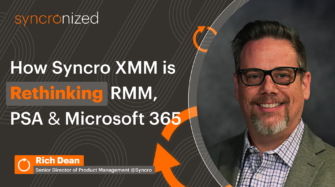According to data from Acronis, a staggering 41% of IT users rarely or never backup their data. In a world where data is a crucial driver of business outcomes and threats like ransomware put data at risk even when teams do perform backups, it’s easy to see why that could be a problem. Data backup and recovery are essential to ensuring business continuity and keeping organizations productive even when something goes wrong.
In this post, we’ll explore data backup and recovery in depth and help IT and MSP pros understand the essentials of this important business continuity topic.
What is data backup and recovery?
Data backup and recovery is the holistic process of creating and restoring data backups.
Backup creation is the first step in the process. Administrators create backups of production data and store them so they can be used if needed. Then, in the event of data loss or a service outage, the recovery process restores the data to production.
Data backup and recovery basics
Let’s break down the basics of data backup and recovery before we dive into more advanced topics.
Common backup methods
The three most common approaches to data backup are:
- Full backups create a complete copy of the source data. Full data backups are easy to manage, but slow to create and take up significant amounts of storage.
- Differential backups create a copy of the data that has changed since the last full backup. From a management and resource consumption perspective, differential backups are the middle of the road between full and incremental data backups.
- Incremental backups create a copy of the data that has changed since the last incremental backup. A series of incremental backups starts with a full backup and includes all the incremental backups since then, making it the most resource-efficient but complex to manage of these three data backup methods.
On-premise vs. cloud vs. hybrid data backups
Fundamentally, there are three approaches to where to store backups: local on-premise storage, in the cloud, or a hybrid combination of both. On-premise gives you full control and can speed up recovery times, but cloud is easier to manage and scalable. Hybrid allows you to “tune the dials” and balance these two options in a way that meets your business requirements.
For a deeper dive into backup methods and on-premise vs. cloud vs. hybrid data backups, check out our blog post on MSP backup solutions.
Common data recovery techniques
The flip side of the data backup coin is the data recovery methods that restore production data. The right approach to data recovery will depend on the type of data loss challenge you are trying to address. The table below breaks down six common data recovery methods and their use cases.
| Data recovery technique | Description | Use case | |
|---|---|---|---|
| Full, incremental, or differential restore | Recovery of a backup using full, incremental, and/or differential backups. | Standard data recovery use cases, such as accidental deletion or file corruption. | |
| Point-in-time recovery (PITR) | Restoration of a database to a specific point in time. | Restoring a database (e.g., a MySQL or Postgres database) to a particular time before a data loss or corruption incident. | |
| Virtual machine snapshot restoration | Restoring a virtual machine based on a snapshot. | Restoring an entire virtual machine to a specific snapshot. |
| Bare-metal restore | Recovery of an entire system onto different (or the same) hardware, including the underlying operating system. | Recovering entire systems without a preinstalled operating system or applications. | |
| Granular recovery | Recovers individual files or folders. | When complete system recovery is not needed, and individual files or folders require restoration. | |
| Disaster recovery as a service (DRaaS) | A third party provides failover and recovery and failover services for a business. | Offloading data backup and recover services and business continuity complexities to a third party and automating DR processes. |
Disasters and other events that create data risk
Multiple internal and external threats exist to critical data in an organization. Let’s examine four of the most common.
Natural disasters
Hurricanes, floods, earthquakes, fires, and other natural disasters can destroy otherwise reliable data centers and leave businesses scrambling to recover. Geographic diversity in your storage locations is one of the best ways to mitigate this risk.
Cyberattacks: Ransomware and other malware
Cyberattacks and malware create a huge risk for modern businesses. In fact, a 2023 Databricks survey found that cyberattacks were the most-cited reason for data loss. Ransomware is one of the most common cyberattacks threat actors use against modern businesses. And — as shown by statistics such as Cybersecurity Ventures’ prediction that by 2031, a ransomware attack will occur every 2 seconds — the risk is only increasing.
Pro-tip: Use offline backups + awareness training to mitigate ransomware risk. Offline (disconnected from the network) backups reduce the risk of ransomware impacting all your client’s data if a network is compromised. Security awareness training helps reduce the risk of employees falling victim to social engineering techniques that enable ransomware infections.
Human error
To err is human. Unfortunately, that error is sometimes an accidental delete or misconfiguration that causes data loss. A reliable backup helps you reduce the risk of a simple mistake completely compromising critical data. Of course, backups should be the last line of defense. Ensure that your IT processes and access controls limit how much damage an individual user could do and leverage automation where practical.
Hardware and software failures
While human error and threat actors are significant risks, technology sometimes fails. For example, BackBlaze’s extensive hard drive test data found a 1.46% annualized failure rate based on data for multiple drive vendors. Similarly, software applications crashing can lead to data corruption.
How to select a data backup strategy
An MSP could solve their clients’ data backup and recovery challenges in many ways. The tricky part is determining how you should solve them given all the different cost, complexity, and business continuity tradeoffs. While no one-size-fits-all answer will work for everyone, the steps below can help you narrow things down and find a solution that works for you.
Understand common backup strategies
3-2-1 backups are the traditional go-to backup strategy, but several alternatives and variants have emerged over the years. The table below breaks down three of the most popular backup strategies.
- 3-2-1 backups: 3 data copies, stored on 2 different media types, and 1 copy offsite.
- 4-3-2 backups: 4 data copies, stored in 3 different locations, and 2 of the locations are offsite.
- 3-2-1-1-0 backups: 3 data copies, stored on 2 different media types, with 1 copy offsite, 1 copy air-gapped, and 0 recoverability errors.
Consider 3-2-1 should be the bare minimum for any critical business data. What I like about 3-2-1-1-0 is that it explicitly calls out recoverability errors. After all, your backups are only as good as your ability to use them.
Ask the right questions
The details matter a lot when it comes to backup and recovery plans. They will not only determine the effectiveness of your solution but also drastically impact cost. Here are eight essential questions to ask as you develop your backup and recover solution strategy.
How much data will be backed up?
There is a big difference in storage costs, data egress, and restoration times between gigabytes (GBs) vs. terabytes (TBs) of data. Quantify how much data your backups will consume to compare cloud and on-prem storage options properly.
How will the data be secured?
Backups are a valuable target for threat actors. You should ensure that your data is properly secured and protected both in the cloud and on-premises.
How will you test your backups?
Failure to test backups is one of the easiest mistakes to make. Have a plan upfront and stick to it.
Does backup creation impact production performance?
Some backup tools and processes can noticeably impact production workloads. Consider the performance impact as you evaluate different solutions.
Are there compliance or data residency concerns?
Regulations and standards like PCI DSS (Payment Card Industry Data Security Standard) and Canada’s PIPEDA (Personal Information Protection and Electronic Documents Act) have requirements around data storage businesses need to consider along with their data backup plan. Similarly, businesses may be subject to specific compliance-driven business continuity requirements.
What RTOs and RPOs make sense?
RTO (recovery time objective) is the acceptable amount of time that can pass before data is restored on a system. RPO (recovery point objective) is the acceptable amount of data loss a system can incur during an incident.
Is CDP right for you?
If your RPO target is 0, real-time backups, also known as CDP (continuous data protection), may be the right approach. CDP backs up changes as they occur to come as close as practical to a 0 RPO.
How much will it all cost?
Unfortunately, backup costs can rack up quickly. The more data you store across more storage locations and mediums, the more cost you incur. Leveraging cold storage or archives can reduce cost, but there is a tradeoff regarding recovery times.
Make a choice that balances cost, risk appetite, and business needs
With answers to the questions above, you should have a good idea of your business requirements and how to make tactical and strategic decisions about your data backup and recovery plan. Based on your needs, you can tweak different high-level strategies, like 3-2-1 backups, to come up with a solution that works for your business.
How Syncro helps MSPs get data backup and recovery right
Syncro is committed to helping MSPs run a more profitable, sustainable, and reliable business for themselves and their clients. As part of that commitment, Syncro has partnered with Acronis to provide affordable, reliable, and scalable backup solutions for MSPs. The Acronis Cyber Backup solution offered through Syncro:
- Is secured by military-grade encryption
- Has no minimums or contract terms
- Comes with reseller pricing that enables MSPs to include a healthy margin in their backup services
If you’d like to take Syncro’s integrated MSP software for a spin yourself, sign up for a free (no credit card required) trial today.
Share














